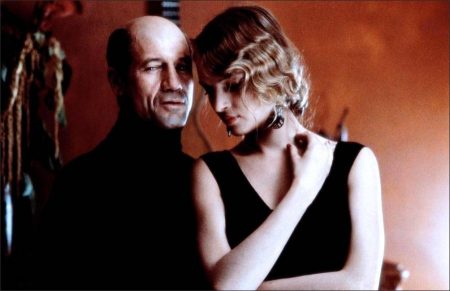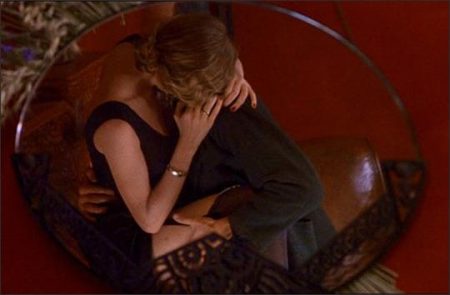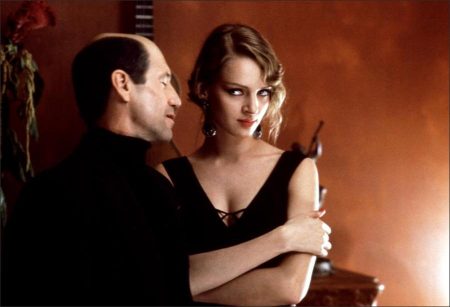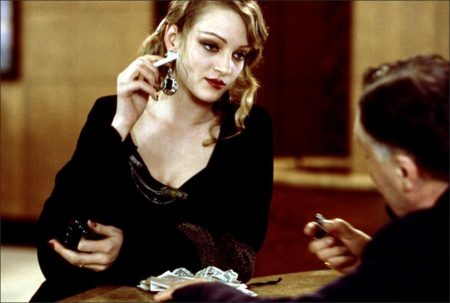Henry and June movie storyline. In 1931 Paris, Anais Nin meets Henry Miller and his wife June. Intrigued by them both, she begins expanding her sexual horizons with her husband Hugo as well as with Henry and others. June shuttles between Paris and New York trying to find acting jobs while Henry works on his first major work, “Tropic of Cancer,” a pseudo-biography of June. Anais and Hugo help finance the book, but June is displeased with Henry’s portrayal of her, and Anais and Henry have many arguments about their styles of writing on a backdrop of a Bohemian lifestyle in Paris.
Henry & June is a 1990 American biographical drama film directed by Philip Kaufman, and starring Fred Ward, Uma Thurman, Maria de Medeiros, Richard E. Grant, Kevin Spacey, Jean-Philippe Écoffey, Bruce Myers, Juan Luis Buñuel, Artus de Penguern and Alexandre De Gall. The film is loosely based on Anaïs Nin’s French book of the same name, and tells the story of Nin’s relationship with Henry Miller and his wife, June.
The film was nominated for Best Cinematography at the 63rd Academy Awards. It is one of three NC-17 films to receive Oscar nominations; the other films are Wild at Heart (1990) and Requiem for a Dream (2000).
Film Review for Henry and June
In its most tender moments, Philip Kaufman’s \”Henry & June\” has a hushed, lyrical grace. The dreamy, modish sensuality is an almost perfect filmic equivalent to Anais Nin’s poetic reveries and reminiscences in her unexpurgated diary, published posthumously in 1986, on which the film is largely based. Despite the film’s advance reputation as an erotic meltdown, its eroticism is far more suggestive than explicit.
“Henry & June” is a film that moves by its own logic of moods and free associations. Kaufman doesn’t work up the usual bullying plot developments to which audiences are accustomed; he’s trying for something far more intuitive and uncoercive than that. He doesn’t succeed all the way through–“Henry and June” is so gentle it almost floats away–but it’s a movie that can’t just be dismissed. It may be a failure but it’s a one-of-a-kind-failure.
Set in Paris in the years 1931-32, “Henry & June” is about Nin (Maria de Medeiros), her fervid affair with author Henry Miller (Fred Ward), and their mutual obsession with Miller’s wife June (Uma Thurman). Nin is the film’s focus and guiding muse. Her face, her eyes are the film’s still center about which all else revolves. And in De Medeiros, Kaufman has an actress who so resembles the young Nin that her presence carries an extra layer of eeriness.
De Medeiros’ presence is more haunting than her performance, however. Kaufman seems as mesmerized by her as Henry and June, but his repeated melting close-ups of her don’t yield new meanings. De Medeiros has a lovely maidenly quality, like the young Lillian Gish, but, unlike Gish, she doesn’t really have the steel or the gumption to ground all that hyperfeminine etherealness. Because her beauty doesn’t deepen as the film wafts along, it takes on a perfume ad quality.
Nin becomes a poster girl for the chic avant-garde. It takes a while, though, before De Medeiros’ Nin wears out her welcome. The introduction of Henry into her life, shortly after her relocation to Paris with her banker husband Hugo (Richard E. Grant), is handled with bemused restraint. Kaufman, who wrote the script with his wife Rose, clearly loves these people, and he deftly orchestrates their erotic feints and parries. Fred Ward’s Henry–on the surface at least–is a blunt, gangsterish semi-buffoon; he’s amused by Nin’s fragile charms, but he’s deeply touched by them too. Their pairing is like a cosmic vaudeville act cooked up in literary heaven.
She’s all inner space, he’s outer space; she’s an American’s idea of the quintessential European lady of grace and quality; he’s the European’s image of the brawling American. They’re excited by the disruptions they cause in each other’s lives, and there’s an added joke: Nin turns out to be more of a free spirit than Henry. She gently needles the closet bourgeois in him. Ward shows how Miller’s overscaled bohemianism was a way of stirring things up, of making his life as torrential as his art.
To a large extent, of course, Miller’s life was inseparable from his art, and the same was true of Nin. There’s a play-act quality to their scenes together that’s richly comic: They’re both trying out scenarios for their books. The ways in which writers use others for their art is a great subject for a comedy, or a tragedy, and “Henry & June” (rated NC-17, the MPAA’s first under the new rating, for explicit sexual situations, nudity and profanity) sometimes touches on the possibilities. When June reads “Tropic of Cancer,” in which she appears, and wails to Henry, “This is not me! You make everything ugly! You used me!,” she’s speaking for all the people who have ever been used as grist for other people’s art.
June is the unifying force in Miller’s and Nin’s passion for each other; because they both desire her, it gives their own love the tingle of the illicit. June, by all rights, should be a femme fatale of mystical proportions but Uma Thurman plays her like a sultry ’60s hippie co-ed. With her bee-stung lips and unplaceable accent and dead-on Dietrich gaze, she’s alluring all right, but also a little absurd in ways I don’t think Kaufman intended.
There should be a fear in her femaleness that strikes Henry to the quick, but we don’t sense it. We also don’t get the erotic thrill that juiced the lives of these players. “Henry & June” is all soul and no body, and that’s a bit too chichi for a film that is supposed to be about sensuality as the elixir of life. It’s possible that, unhampered by any ratings code, Kaufman would have made a film more genuinely erotic than this; he’s too fine an artist to contrast a heaving couple with a steaming kettle, as he does in one scene.
Nin’s spiritual odyssey is her sexual odyssey, but because her sex scenes with Henry and with June have no steam heat, we never sense what’s at stake for her psyche. Kaufman is so gaga over this Nin that her shallow narcissism has no danger. It’s possible that Kaufman imagined himself so deeply into the erotic reveries of these people that he couldn’t find his way out.
The film is beautifully made yet hermetic, like some of Alan Rudolph’s films. It’s probably intentional that everyone in this film seems to be rehearsing in front of a mirror, but the unreality gets to you after a while. For movie lovers, though, there may be a consolation prize in all this: “Henry & June” is the kind of mess that only a major filmmaker could concoct. Its mistakes arise from challenges beyond the reach of all but a handful of American filmmakers. Kaufman hasn’t pulled off \”Henry & June,\” but how many film directors would have even attempted it?
Henry and June (1990)
Directed by: Philip Kaufman
Starring: Fred Ward, Uma Thurman, Maria de Medeiros, Richard E. Grant, Kevin Spacey, Jean-Philippe Écoffey, Bruce Myers, Juan Luis Buñuel, Artus de Penguern, Alexandre De Gall
Screenplay by: Philip Kaufman, Rose Kaufman
Production Design by: Guy-Claude François
Cinematography by: Philippe Rousselot
Film Editing by: Dede Allen, Vivien Hillgrove, William S. Scharf
Costume Design by: Yvonne Sassinot de Nesle
Art Direction by: Thierry François
Music by: Mark Adler
MPAA Rating: NC-17
Distributed by: Universal Pictures
Release Date: October 5, 1990
Views: 1782





